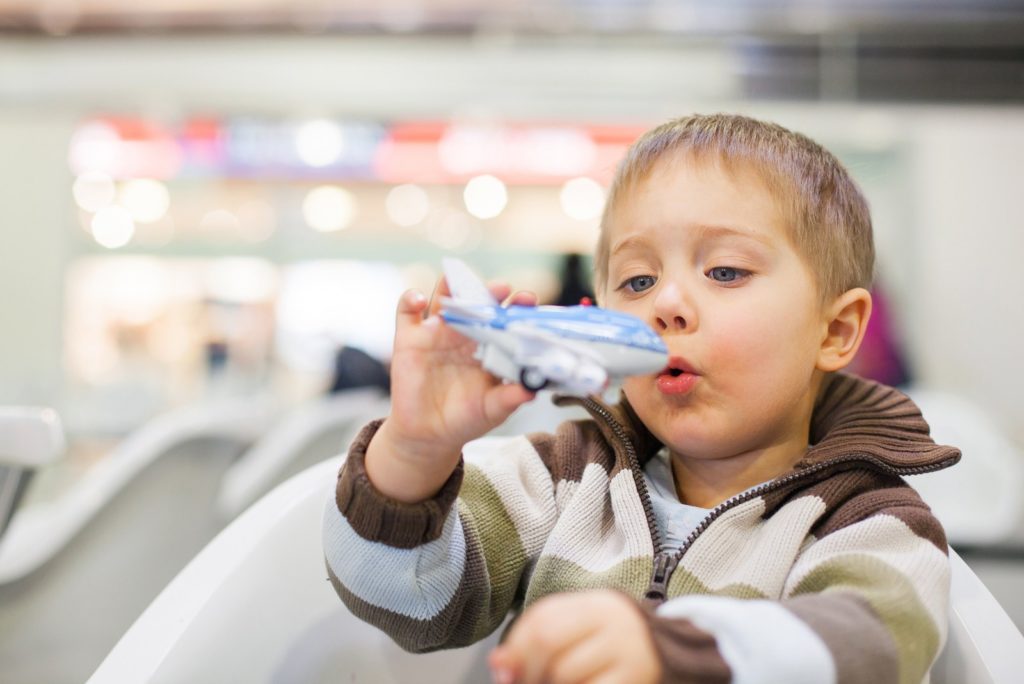Top 10 tips for flying with kids

We have traveled long haul international (14 + hrs) with our kids from as young as six weeks old (the youngest recommended age to travel) – and believe it or not, the younger they are, the easier it is!
With holidays just around the corner, here are my top 10 tips to ease the stress and make flying with kids a little more bearable!
1) Timing, Timing, Timing! For long haul flights, where possible, time your flight with when your kids would normally be sleeping. Late afternoon or early evening departures are ideal. This way, you can encourage your kids to sleep on the plane (when they would normally be sleeping), and the majority of the flight time would have passed overnight. This is a win-win for you, your kids, and fellow passengers!
2) If breast or bottle feeding, feed your child on take-off and landing. The sucking motion can prevent, or minimise the pressure for little ears. A dummy can also be useful. Time your plane trip when it is normally feeding time – the hungrier your baby is, the more inclined they will be to suck. The airline can heat bottles for you if using formula – just be sure to ask well in advance before you need it.
3) Kids under two travel free (if they are on your lap, or you book a bassinet). If you’re traveling on a long flight with an infant, I recommend asking your airline or travel agent if it’s possible to reserve a bassinet on board when booking your tickets. The benefits to booking a bassinet is that your baby gets a place to sleep, and you get your hands – and lap – free for at least part of the flight, at no extra cost. Availability is not always guaranteed, as priority is sometimes given to the youngest child on board. All airlines have varying guidelines for bassinets, with the cut off age ranging from six months to two years, and varying height and weight requirements. Best to check with your airline when making the booking. Kids over two will need their own seat.
For shorter international flights (such as Indonesia, Fiji etc) which use domestic air crafts, there are no bassinets
4) If traveling to another time zone (long International flights), I recommend changing over to the new time zone as soon as you arrive for meal times, nap times, and bed times. Exposure to as much natural sun light as possible during the day will help kick in their circadian rhythm and speed up the adjustment process. It is equally important to keep the environment for nap and bed time very dark. Keep naps to the same length as back home (i.e. don’t let your kids sleep for 5hrs straight during the day, or this will eat into their night sleep). If you need to give them an extra day nap in the first couple of days, that’s fine. Try and do meal times etc in accordance with the new time zone. It may take a couple of days to adjust, but kids are very adaptable. Breastfed babies may take a few more days to adjust because their mother’s milk supply has to adjust for the time zone as well.
For other time zones which only differ by a couple of hours from home – interstate in Australia, Indonesia, NZ, Fiji, etc. then slowly adjust to the new time zone by moving nap times, meal times, and bed time gradually (forward or backward by 15-30 mins per day) over a few days (similar to daylight savings transition).
5) Remain consistent, and keep to your normal day and night routine as much as possible. This includes nap times, sleep associations and cues, meal times, and bed times. To make the transition easier, bring all your child’s creature comforts to replicate your child’s home sleep environment. This includes; white noise machine/app on iPad, sleeping bag, comforter, cot blankets, and black out blind/foil for darkening light rooms for naps.
6) Useful things to pack in your carry on: Australian Bush Flower Travel Essence, Evian water spray, nappies, wipes, a couple of changes of loose and comfortable clothing (in case of accidents), plenty of snacks, formula, bottles, blanket, warm swaddle/sleeping bag, comforter, dummies, sippy cups, entertainment (books, cards, movies, toys, colouring etc), baby carrier/wrap (for the sometimes long immigration process), iPad and phone charger (most airports have charging docks), kids headphones (from Target/Big W etc). There is a change table available in one of the toilets on board which your flight attendant will advise, and some airlines provide baby food and kids activities on request if you get stuck, however – I would ALWAYS take your own.
7) Order a special meal for the airplane when you book your tickets (e.g. vegetarian, baby etc.). This way you’re guaranteed to get your meals first; a perk when wrangling hungry toddlers
8) I recommend paying for Airport lounge membership (Average is around $50 per visit). Nothing beats the comfort of the lounges, food, and drinks, and some even have a kids play area!
9) Take your stroller with you! Most airlines allow you to take them right up to the gate, and you can either collect when you get off the plane, or it will be available in oversized luggage. Check with your airline as to their policy and where to collect.
10) Organise your hotel transfers/transport in advance. Ensure your method of transport is large enough to accommodate you, the kids, luggage, and stroller. Most transfers are arranged through your hotel/accommodation, so be clear on your requirements when you book.
If you have any other tips to add for plane travel with kids, I would love to hear from you!
